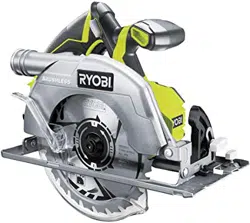Loading ...
Loading ...
Loading ...

3
the blade is in motion or kickback may occur.
Investigate and take corrective actions to eliminate the
cause of blade binding.
Ŷ When restarting a saw in the workpiece, centre the
saw blade in the kerf and check that saw teeth are
not engaged into the material. If saw blade is binding,
it may walk up or kickback from the workpiece as the
saw is restarted.
Ŷ Support large panels to minimise the risk of blade
pinching and kickback. Large panels tend to sag
under their own weight. Supports must be placed under
the panel on both sides, near the line of cut and near
the edge of the panel.
Ŷ Do not use dull or damaged blades. Unsharpened
or improperly set blades produce narrow kerf causing
excessive friction, blade binding and kickback.
Ŷ Blade depth and bevel adjusting locking levers
must be tight and secure before making cut. If blade
adjustment shifts while cutting, it may cause binding
and kickback.
Ŷ Use extra caution when sawing into existing walls
or other blind areas. The protruding blade may cut
objects that can cause kickback.
LOWER GUARD FUNCTION
Ŷ Check lower guard for proper closing before each
use. Do not operate the saw if lower guard does not
move freely and close instantly. Never clamp or
tie the lower guard into the open position. If saw is
accidentally dropped, lower guard may be bent. Raise
the lower guard with the retracting handle and make
sure it moves freely and does not touch the blade or any
other part, in all angles and depths of cut.
Ŷ Check the operation of the lower guard spring. If
the guard and the spring are not operating properly,
they must be serviced before use. Lower guard may
operate sluggishly due to damaged parts, gummy
deposits, or a build-up of debris.
Ŷ Lower guard may be retracted manually only for
special cuts such as “plunge cuts” and “compound
cuts”. Raise lower guard by retracting handle and as
soon as blade enters the material, the lower guard
must be released. For all other sawing, the lower guard
should operate automatically.
Ŷ Always observe that the lower guard is covering the
blade before placing saw down on bench or floor.
An unprotected, coasting blade will cause the saw to
walk backwards, cutting whatever is in its path. Be
aware of the time it takes for the blade to stop after
switch is released.
ADDITIONAL SAFETY WARNINGS
Ŷ The dust produced when using the product may be
harmful to your health, inflammable, or explosive.
Do not inhale the dust. Use a dust extraction system,
and wear a suitable dust protection mask. Remove
deposited dust thoroughly, e.g., with a brush and
vacuum cleaner.
Ŷ Do not use any abrasive wheels.
Ŷ Use only blades specified in this manual, complying
with EN 847-1.
Ŷ Avoid overheating the blade tips. Do not use dull or
damaged blades. Do not force the tool.
Ŷ Do not use blades of larger or smaller diameter than
recommended.
Ŷ Wear ear protection.
Ŷ Clamp workpiece with a clamping device.
Unclamped workpieces can cause severe injury and
damage.
Ŷ Thoroughly check the material to be cut, particularly
when using recycled wood, for foreign objects such
as nails, screws, and staples. If nails, screws, staples
or similar items contact the blade whilst cutting, the saw
will be damaged and severe injury to the operator or
others may occur.
Ŷ Do not touch the saw blade immediately after
sawing. The saw blade gets hot during sawing.
WARNING
The product is not intended for use by persons (including
children) with reduced physical, sensory or mental
capabilities, or lack of experience and knowledge,
unless they have been given supervision or instruction
concerning use of the product by a person responsible
for their safety.
Children should be supervised to ensure that they do not
play with the product.
TRANSPORTING LITHIUM BATTERIES
Transport the battery in accordance with local and national
provisions and regulations.
Follow all special requirements on packaging and labelling
when transporting batteries by a third party. Ensure that
no batteries can come in contact with other batteries
or conductive materials while in transport by protecting
exposed connectors with insulating, non-conductive caps
or tape. Do not transport batteries that are cracked or
leaking. Check with the forwarding company for further
advice.
RESIDUAL RISKS
Even when the product is used as prescribed, it is still
impossible to completely eliminate certain residual risk
factors. The following hazards may arise and the operator
should pay special attention to avoid the following:
Ŷ Injury caused by kickback
– Read and understand the information in this manual.
Ŷ Injury caused by vibration
– Limit exposure. See Risk Reduction.
Ŷ Injury caused by dust
– Wear eye protection at all times. Wear appropriate
dust mask with suitable filters that can protect
against particles from the material being worked on.
Do not eat, drink, or smoke in the work area. Ensure
adequate ventilation.
Ŷ Electric shock
– The blade may contact hidden wiring causing
Loading ...
Loading ...
Loading ...
